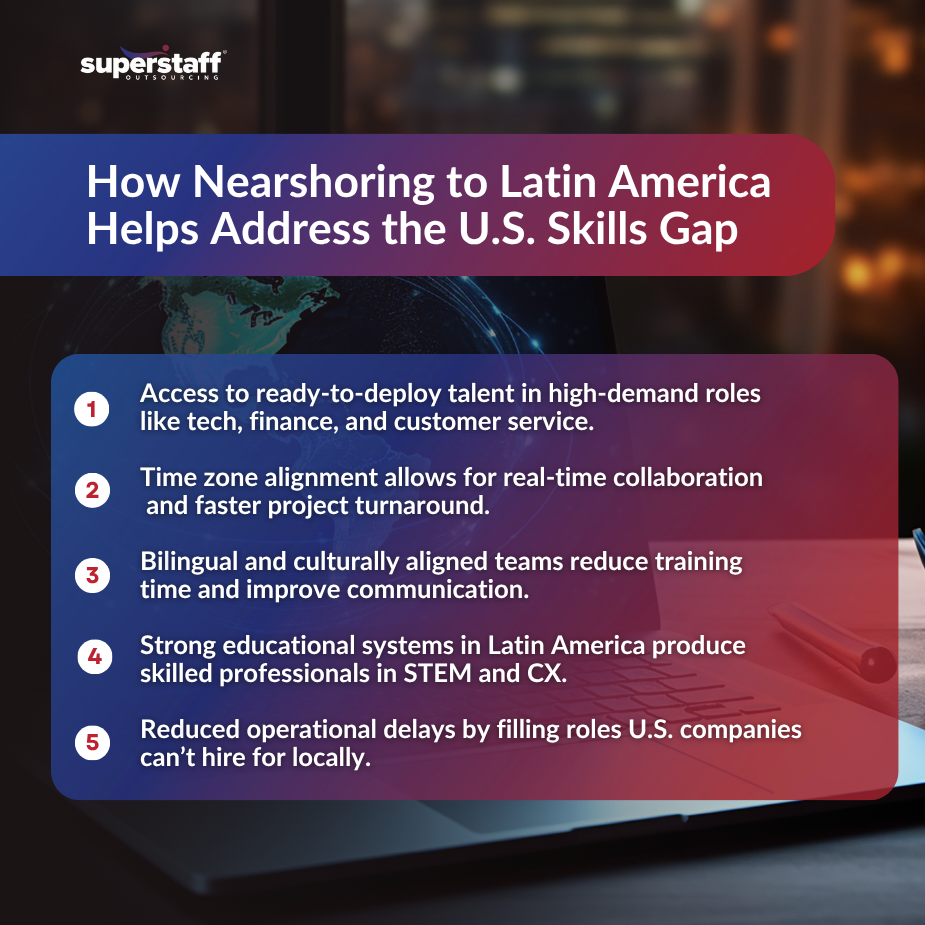
The U.S. isn’t just facing a hiring challenge—it’s facing a full-blown skills crisis. Across industries, businesses are struggling to find qualified workers fast enough to meet demand. From software development and cybersecurity to healthcare administration and multilingual customer service, the talent gap is widening—and it’s slowing growth, innovation, and customer satisfaction.
Fortunately, a solution is emerging just south of the border. Countries throughout Latin America are producing a new generation of skilled professionals ready to fill critical roles. With strong English proficiency, cultural compatibility, and a growing emphasis on digital and customer-facing skills, the region is proving to be more than just a cost-effective labor market. Nearshoring Latin America isn’t just about affordability—it’s about access to high-performing, agile talent that aligns with U.S. business hours and expectations.
In this blog, we’ll break down why nearshoring Latin America has become a strategic move for U.S. companies facing hiring bottlenecks. We’ll explore how nearshore teams help close the skills gap, boost productivity, and future-proof operations. Whether you’re scaling tech support, building out a DevOps team, or expanding your customer experience capabilities, Latin America may be the answer you’re looking for.
The U.S. Skills Gap Is Widening—And It’s Costing Companies
The demand for skilled workers in the U.S. has outpaced supply, leading to real business risks. According to various research studies, labor shortages are most acute in tech, healthcare, customer service, and finance. In fact, Korn Ferry predicts that, in just five years, over 85 million roles could go unfilled because of a dearth in qualified workers.
The root causes are many: an aging workforce, reduced immigration, a mismatch between education and job market needs, and rapidly evolving technologies. As these pressures mount, companies are experiencing skyrocketing wage demands, higher turnover, delayed product releases, and growing customer complaints.
Companies can no longer wait for the local talent pipeline to catch up. With critical roles left vacant for months, organizations are forced to expand their talent search beyond U.S. borders—but not too far.
How Nearshoring in Latin America Solves the U.S. Skills Gap
Latin America offers the proximity, talent, and agility U.S. companies need right now. Countries like Colombia, Mexico, Costa Rica, and Argentina have become top destinations for nearshore outsourcing because they deliver more than just cost savings—they deliver qualified, bilingual professionals in high-demand roles.
Shared time zones allow teams to collaborate in real-time without the scheduling hurdles associated with traditional offshoring. English proficiency is rising steadily, with major urban hubs producing CX agents, engineers, financial analysts, and healthcare support workers equipped to meet global standards.
Robust universities and public-private initiatives are accelerating the development of STEM and digital skills, while cultural compatibility ensures easier integration with U.S.-based teams. In cities like Bogotá, Monterrey, and San José, investments in digital infrastructure make remote work seamless and secure.
Latin America isn’t just participating in the global economy—it’s redefining its role in it.

Seamless Collaboration Across Borders: The Nearshoring Advantage
Nearshoring supports real-time collaboration, making remote feel local. When teams operate in the same or similar time zones, communication gaps shrink. Agile workflows move faster. Projects stay on track.
This is especially important for U.S. businesses adopting DevOps, Agile, and hybrid work models. With nearshoring Latin America, daily stand-ups, sprint reviews, and troubleshooting sessions happen in sync. There’s no need to wait overnight for updates or compromise on responsiveness.
Bilingual support teams also reduce training costs and help brands deliver superior customer experiences. With tools like Zoom, Jira, and Slack standard across regions, collaboration feels as natural as if the team were sitting in the next room.
These operational efficiencies turn nearshoring from a tactical decision into a long-term competitive strategy.
Filling High-Demand Roles Without Compromising Quality
From developers to analysts to multilingual support agents, Latin America offers ready-to-deploy talent that meets U.S. business needs. The region’s focus on digital skills and workforce development has created deep talent pools in AI, cybersecurity, software engineering, and finance.
Healthcare support, insurance processing, and multilingual CX are also on the rise, with many professionals holding global certifications like PMP, ITIL, AWS, and more. Whether your company needs to build a nearshore call center or expand its IT capacity, you’ll find specialists who are not only skilled but also eager to grow with your business.
Several top nearshoring companies in Latin America, including SuperStaff, have developed rigorous hiring, training, and compliance frameworks to ensure quality. With the right partner, companies can tap into world-class capabilities without the risk of underperformance.
Nearshoring vs. Offshoring: What Makes LATAM a Strategic Fit for U.S. Companies
While offshoring to regions like Southeast Asia has long been a cost-effective option, nearshoring to Latin America bridges more than just the price gap. It brings teams closer in every way that matters—time, culture, and compliance.
Nearshore call centers in Colombia or Costa Rica typically report lower attrition and higher employee engagement compared to offshore counterparts. That translates to better continuity, more personalized service, and stronger brand alignment.
Compliance is also more manageable, thanks to closer regulatory alignment and regional stability. Many top nearshoring companies in Latin America already adhere to global data security standards and privacy laws, reducing risk for U.S. partners.
By staying closer to home, companies reduce both operational friction and long-term risk—all while scaling with speed.
How to Get Started With Nearshoring in Latin America
A smooth nearshoring launch starts with the right partner and a clear roadmap. Begin by identifying the skills you need most and assessing your internal capacity. Then, define the roles and responsibilities that can be transitioned to a nearshore team.
Look for top nearshoring companies in Latin America with proven experience, bilingual capabilities, and secure infrastructure. Strong partners like SuperStaff offer end-to-end support—from recruitment and onboarding to training and performance monitoring.
It’s also important to establish clear expectations through KPIs, SLAs, and regular feedback loops. Security protocols and compliance planning should be non-negotiable, especially if your operations involve sensitive customer data.
With the right structure in place, nearshore teams in Latin America can function as a seamless extension of your in-house workforce.
Nearshoring Latin America: Your Secret Weapon in the Global Talent War
The U.S. skills gap may be growing, but smart companies aren’t standing still—they’re turning to Latin America’s nearshore workforce. Nearshoring Latin America offers a modern, agile solution that delivers high-quality talent, real-time collaboration, and lasting ROI.
With rising digital capabilities, strong cultural alignment, and scalable team models, nearshore call centers and professional service hubs in Latin America are transforming how companies hire, scale, and compete.
If your business is ready to bridge the talent gap without sacrificing speed or quality, SuperStaff’s nearshore solutions in Latin America can help. Let’s build your next high-performance team—starting today.






